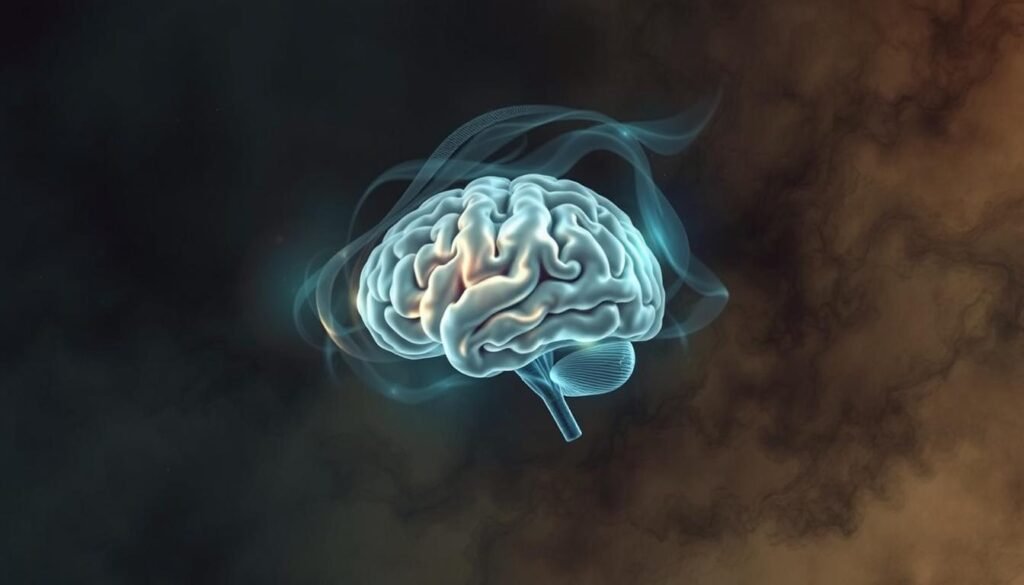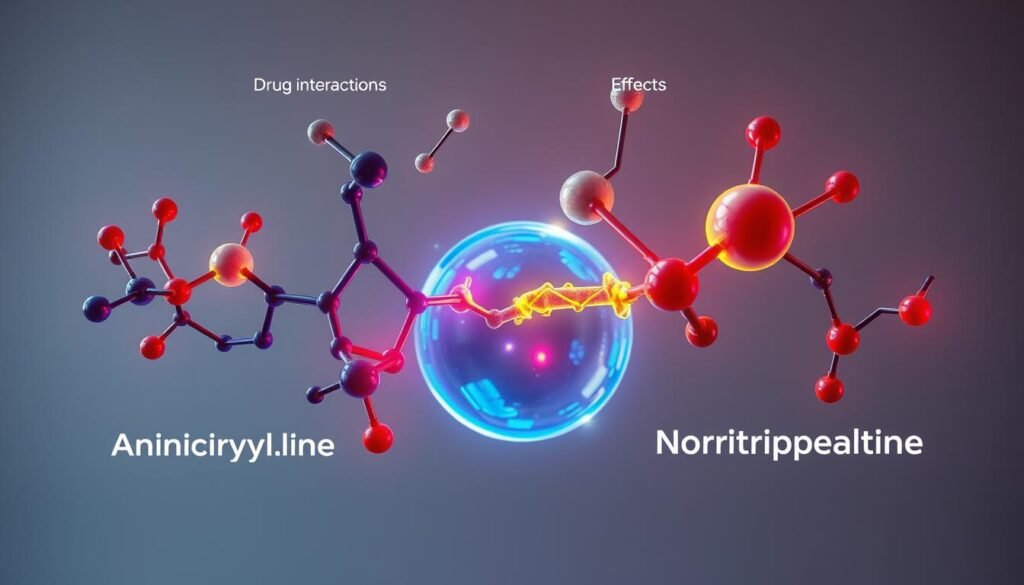Did you know tricyclic antidepressants (TCAs) were some of the first antidepressants made? They’ve been passed by newer drugs with fewer side effects. Yet, Amitriptyline and Nortriptyline remain vital for treating depression and mood disorders. These TCAs are approved by the U.S. FDA for major depressive disorder (MDD). They are also used for obsessive-compulsive disorder and chronic pain.
Learning about Amitriptyline and Nortriptyline’s benefits, how to dose, and their side effects is key. This article digs deep into how these medications work. It focuses on their effectiveness and safety in treating depression.
Key Takeaways
- Tricyclic antidepressants, including Amitriptyline and Nortriptyline, are significant in managing depression.
- Amitriptyline and Nortriptyline are FDA-approved for major depressive disorder.
- Both TCAs have additional approved uses beyond depression.
- It’s crucial to understand the side effects associated with these medications.
- Proper dosing and management can enhance treatment efficacy.
Introduction to Tricyclic Antidepressants (TCAs)
Tricyclic antidepressants, or TCAs, have been key in treating depression since 1959. Starting with imipramine, they boost mood-improving neurotransmitters like serotonin and norepinephrine. Although newer drugs such as SSRIs are preferred, TCAs are still important for those not helped by other treatments.
TCAs serve as a second choice because of their side effects and safety risks. Still, they’re effective for more than depression, like pain and migraines. They work at lower doses for pain than depression.
There are 10 FDA-approved TCAs, with amitriptyline and nortriptyline being common picks. Their success and the best dose vary by the problem treated. For depression, nortriptyline’s effective level is between 50-150 ng/mL in the blood. Users of TCAs need careful watching for side effects such as drowsiness, weight gain, and heart problems.
How TCAs Work in Treating Depression
Tricyclic antidepressants, or TCAs, are key in managing depression. They have a unique mechanism of action. These medicines focus on stopping the reuptake of neurotransmitters, mainly serotonin and norepinephrine. This action boosts the levels of these vital neurotransmitters in the brain, lifting mood and relieving depressive symptoms.
The main job of TCAs is to change how neurons communicate and the chemistry of the brain. This is crucial in fighting depression. Studies show that TCAs not only improve mood. They also help with other conditions like chronic pain and fibromyalgia. This makes them highly valuable in treatment.
To truly understand how TCAs work, it’s important to see their role in depression care. They balance the levels of neurotransmitters and change the brain’s way of handling mood signals. This can greatly help a patient’s life improve. Below, you’ll find a table that outlines the main actions of TCAs and their benefits in depression treatment:
| Mechanism | Effect on Neurotransmitters | Impact on Depression |
|---|---|---|
| Reuptake Inhibition | Increases serotonin and norepinephrine levels | Enhances mood and reduced depressive symptoms |
| Neuronal Communication | Improves signals for mood regulation | Promotes emotional stability |
| Chronic Pain Relief | Modulates pain pathways | Improves overall well-being in depressed individuals with pain |
Common TCAs Used for Depression: Amitriptyline and Nortriptyline
Amitriptyline and Nortriptyline are popular choices for treating depression. They are tricyclic antidepressants (TCAs) approved by the FDA. These drugs boost serotonin and norepinephrine in the brain. This action helps in depression treatment. Usually, within two months, 71% of patients get to the right drug levels, on average taking about 19.6 days.
Amitriptyline is known by names like Elavil and Vanatrip. It’s also used for chronic pain, fibromyalgia, and anxiety, not just depression. Nortriptyline, sold as Aventyl and Pamelor, is effective for ADHD, chronic pain, and insomnia besides depression. It tends to work faster than other TCAs.
Today, SSRIs and SNRIs are more common for treating depression, making TCAs like Amitriptyline and Nortriptyline less common as first choices. However, doctors often prescribe them for other conditions, showing their wide use. But there are side effects like constipation, dizziness, and weight gain. People with certain conditions need to be cautious because of the drugs’ anticholinergic effects.
Benefits of Amitriptyline in Depression Treatment
Amitriptyline is a key tricyclic antidepressant (TCA) that helps a lot with depression. It does more than just ease depressive symptoms, it also helps with other conditions. This makes it a great choice for healthcare providers. Knowing how Amitriptyline works shows us its power in improving mood and emotional stability.
Mechanism of Action
The main mechanism of action of Amitriptyline is to increase serotonin and norepinephrine in the brain. It stops these neurotransmitters from being taken back up, which helps nerve cells communicate better. This is vital for treating major depressive disorder and boosts overall wellbeing.
Approved Uses Beyond Depression
Amitriptyline isn’t just for depression; it also treats chronic pain, migraines, and anxiety disorders. Its ability to manage different symptoms shows its usefulness. Research proves it works well for various conditions, making it a key option for chronic pain relief too.
In summary, Amitriptyline’s benefits for depression come from its proven action and wide range of uses. It provides patients a strong method to handle their symptoms while also tackling other health issues.
Benefits of Nortriptyline in Depression Treatment
Nortriptyline is a standout drug among tricyclic antidepressants for fighting depression. Its benefits reach beyond just being effective. It has a special feature: it doesn’t make you too sleepy. This is great for those who need a treatment that won’t slow them down during the day.
Less Sedation Compared to Other TCAs
This TCA causes less sedation than others like Amitriptyline. This feature is key for people who want to stay active.
Nortriptyline boosts serotonin and norepinephrine, helping to lift depression. Though it might make some a bit sleepy, it usually doesn’t disrupt daily life.
When used for nerve pain, Nortriptyline starts working in about a week. For full depression relief, it may take four to six weeks. This shows its broad use, not only for mood but also for pain.
Side effects like dry mouth and constipation are common but often short-lived. Many find these side effects tolerable during treatment.
Nortriptyline comes in various strengths, making treatment flexible. Adults often start on 75mg to 100mg daily for depression. The dose might increase based on medical advice. This customization is key in meeting each patient’s needs.
The benefits of Nortriptyline go beyond just curing depression. Its low sedation impact highlights its value, offering a better experience for many on antidepressants.
Possible Side Effects of Amitriptyline and Nortriptyline
Knowing the side effects of Amitriptyline and Nortriptyline is important. These drugs help with depression and different pain types. But, they also bring possible risks. It’s key to understand both common and serious side effects. This helps in making wise health decisions.
Common Side Effects
While on these medications, patients may face common side effects. These can affect everyday life but are usually manageable. Some of these are:
- Drowsiness
- Dry mouth
- Blurred vision
- Constipation
- Nausea
- Weight gain
- Difficulty thinking clearly
- Lightheadedness
- Sexual dysfunction
Serious Side Effects
On the other hand, some might have more severe side effects that need quick medical help. These include:
- Irregular heartbeat or chest pain
- Seizures or fits
- Fainting or falls
- Difficulty passing urine
- Severe mood changes
- Frequent infections
- Signs of an allergic reaction, such as hives or difficulty breathing
Staying informed about these side effects is crucial. Monitoring health and quickly addressing any bad reactions is vital during treatment.

Dosage Considerations for Amitriptyline and Nortriptyline
Finding the right dosage for Amitriptyline and Nortriptyline is crucial. It helps improve outcomes and reduces side effects. These medicines are known as tricyclic antidepressants. They’re used to treat depression and other ailments. The dose you take can greatly affect how well you respond to the treatment.
For Nortriptyline, adults usually take 25-150 mg per day, and teens might take 30-50 mg per day. You can get them in capsules or liquid form. This makes it easy to meet different needs. Amitriptyline’s usual dose is 25-50 mg per day, but some may take up to 200 mg per day. It mostly comes in tablets, with doses from 10 mg to 150 mg.
It’s important to get the dose just right, especially if you have certain health issues or take other drugs. Knowing the right amount of Amitriptyline and Nortriptyline helps get good results and avoid problems like dry mouth, sleepy feelings, or weight change.
Doctors suggest raising the dose slowly. This lets them make adjustments as needed, based on your reaction. Regular check-ins with your doctor help keep track of how well the medicine works. They can change your dose if necessary. For more details on managing depression medicines, click here.
Drug Interactions with TCAs
Knowing how drugs interact is key when using tricyclic antidepressants (TCAs) like Amitriptyline and Nortriptyline. These medicines can mix with others in ways that cause harmful effects. Paying close attention to these interactions improves treatment success.
Common Interactions to Watch For
Using TCAs calls for caution with certain drugs. Knowing what to watch for can help avoid treatment risks. Here’s what to keep in mind:
- Selective Serotonin Reuptake Inhibitors (SSRIs): Combining SSRIs with Amitriptyline or Nortriptyline might up the risk of severe serotonin syndrome.
- Pain Medications: Some pain relievers can increase the calming effects of TCAs unexpectedly.
- Herbal Supplements: St. John’s Wort can react badly with TCAs, raising the chance of serotonin syndrome and other issues.
- Alcohol: Drinking alcohol while taking TCAs can deepen sedation and heighten the danger of serious side effects.
There are more possible interactions with TCAs than these few. So, patients and doctors must check all other medicines being taken together. For an in-depth look at these interactions, check out this detailed resource.
| Drug Type | Interaction with TCAs | Potential Consequences |
|---|---|---|
| SSRIs | Increased risk of serotonin syndrome | Symptoms: confusion, rapid heart rate, high blood pressure |
| Pain Medications | Enhanced sedation | Increased dizziness, impaired coordination |
| St. John’s Wort | Heightened risk of serotonin syndrome | Symptoms: agitation, hallucinations, loss of consciousness |
| Alcohol | Increased sedation and dizziness | Potential for overdose and severe side effects |

Alternative Treatments for Depression
Looking at different ways to treat depression shows many effective mental health solutions. There are more choices than just old-school drugs like tricyclic antidepressants. These options can make overall health better and offer a full plan for treatment options.
There are many non-traditional medicines, with SSRIs and SNRIs being top picks. Medicines like Duloxetine (Cymbalta) and Venlafaxine (Effexor) are good choices. These help with depression and also with fibromyalgia and anxiety. SSRIs like Fluoxetine (Prozac) also help with a wide range of issues such as obsessive-compulsive and panic disorders.
Drugs like Mirtazapine (Remeron) work well for depression with fewer side effects. Also, tricyclics like Nortriptyline (Pamelor) are good but with some side effects. They help with other issues too, like preventing migraines.
Aside from drug treatments, cognitive behavioral therapy (CBT) and changing lifestyle habits show great results. Physical activities and therapy can hugely drop depression levels. It’s smart to talk about all alternative treatments with a doctor. This way, you can find the best way to handle mental health. This leads to a better life quality and outcomes in the long run.
Comparing TCAs to Other Antidepressants
When looking at treatments for Major Depressive Disorder (MDD), TCAs like Amitriptyline and Nortriptyline offer insights. They compare to Selective Serotonin Reuptake Inhibitors (SSRIs). SSRIs are the top choice now because they are safer.
SSRIs Versus TCAs
TCAs, such as Amitriptyline and Nortriptyline, work well to fight depression. They change serotonin and norepinephrine levels. But, they can cause strong side effects including sleepiness and dry mouth.
SSRIs like fluoxetine and sertraline have fewer bad effects. This makes them more popular with doctors.
| Feature | TCAs (Amitriptyline & Nortriptyline) | SSRIs (e.g., Fluoxetine, Sertraline) |
|---|---|---|
| FDA Approval for Depression | Yes | Yes |
| Common Side Effects | Drowsiness, dry mouth, weight changes | Nausea, insomnia, sexual dysfunction |
| Risk of Anticholinergic Effects | Higher | Lower |
| Drug Interactions | Multiple interactions; caution needed | Fewer interactions generally |
| Recommended Usage | Often monitored; dose adjustments needed | Frequently prescribed as first-line therapy |
SSRIs are usually chosen for their safety. Yet, TCAs might be better for some who don’t improve with new drugs. Genes can affect how well treatments work, showing why personalized care is key in fighting depression.

Long-Term Safety and Efficacy of Amitriptyline and Nortriptyline
Understanding long-term treatment for depression is vital. It’s crucial to know how medications like Amitriptyline and Nortriptyline work. Research including 103 trials with 10,590 people shows their lasting effect. These studies show TCAs have a clear benefit over placebo, with a -3.77 mean difference on the Hamilton Depression Scale.
However, these medications come with some risks. Compared to placebo, tricyclic antidepressants doubled the risk of serious side effects. This information calls for careful consideration by patients looking at long-term treatments for their depression.
Not many studies looked into how these drugs affect life quality. Most research was short-term, ending at 12 weeks post-treatment start. This gap raises questions about the long-term impact of TCAs on life quality and suicide risks. There’s a real need to dig deeper into these areas.
Amitriptyline is recognized by the WHO for its effectiveness in treating depression. But, Nortriptyline requires caution, especially for those with heart issues, or who are pregnant, breastfeeding, or have allergies. Knowing how these drugs interact with others is especially important for the elderly and young people. They face more risks.
A careful look into the long-term use of these drugs is needed. Patients must weigh the pros and cons in their depression treatment journey.
Conclusion
Amitriptyline and Nortriptyline are key in treating depression. They are tricyclic antidepressants. These medicines help with depressive symptoms and other issues like pain and migraines. Their dual purpose shows how they improve health and wellness.
It’s crucial for patients to talk with their doctors about these medicines. Nortriptyline and Amitriptyline work differently for everyone. Understanding how they affect you is important. Patients should be active in their treatment choices. Monitoring for side effects and interactions is also necessary.
Open discussions about mental health can improve results. Knowing about treatment options, including SSRIs, is vital for mental well-being. For more information, you can check out this comprehensive resource. It highlights the importance of personalized mental health conversations.